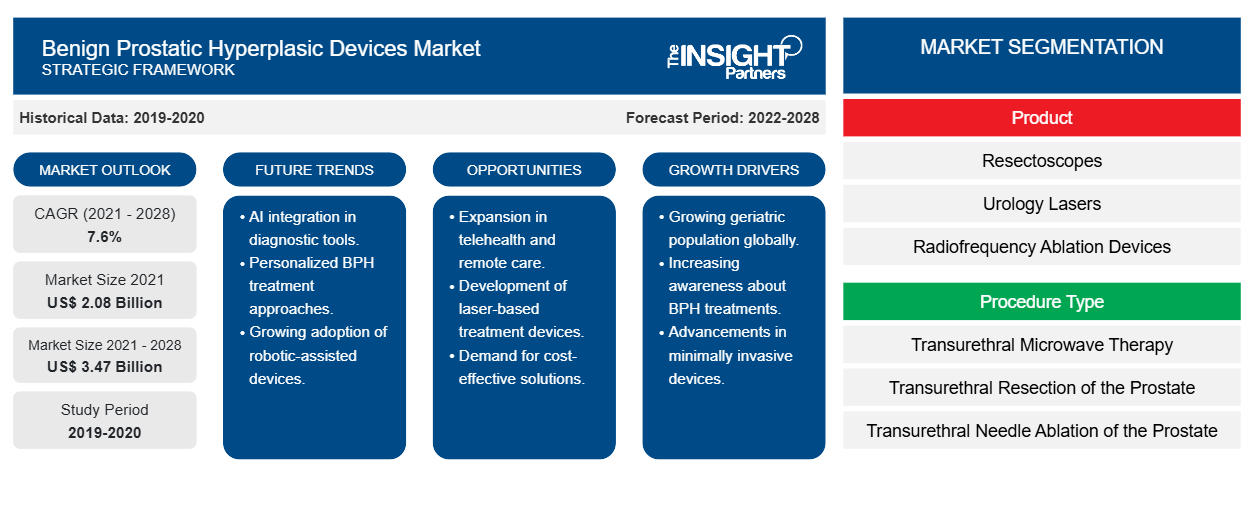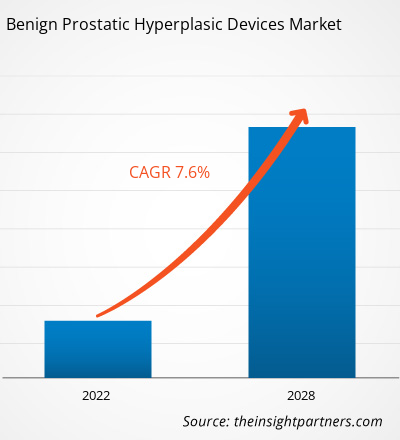[Research Report] The benign prostatic hyperplasic devices market is expected to grow from US$ 2,078.78 million in 2021 to US$ 3,467.31 million by 2028; it is estimated to grow at a CAGR of 7.6% from 2022 to 2028.
Benign prostatic hyperplasia (BPH) is a prostate enlargement caused by excessive cell growth in the prostate. BPH is a benign (non-cancerous) prostate condition. Non-cancerous conditions are not usually fatal and do not spread (metastasize) to other body parts. BPH doesn't raise the risk of prostate cancer; unless it manifests symptoms, BPH isn't considered a health issue. Almost all men will have some prostate growth by the age of 70. Getting older, having more belly fat (also known as abdominal obesity), and not getting enough exercise to raise the risk of developing BPH.
The benign prostatic hyperplasic devices market is segmented into product, procedure type, end user, and geography. By geography, the market is broadly segmented into North America, Europe, Asia Pacific, the Middle East & Africa, and South & Central America. This report offers insights and in-depth analysis of the market, emphasizing parameters, such as market trends, market dynamics, and the competitive analysis of the globally leading market players.
Customize This Report To Suit Your Requirement
You will get customization on any report - free of charge - including parts of this report, or country-level analysis, Excel Data pack, as well as avail great offers and discounts for start-ups & universities
Benign Prostatic Hyperplasic Devices Market: Strategic Insights

-
Get Top Key Market Trends of this report.This FREE sample will include data analysis, ranging from market trends to estimates and forecasts.
Market Insights
Increase in prevalence of benign prostatic hyperplasia along with growing risk factors, and a rise in investments, funds, and grants for research in BPH treatment to drive benign prostatic hyperplasic devices market.
According to the National Center for Biotechnology Information (NCBI), BPH is one of the most common disorders in older men and the leading cause of lower urinary tract symptoms (LUTS). After the age of 40, the prevalence of BPH rises, reaching a peak of 60% by the age of 90. According to autopsy studies, the histological prevalence of BPH is 8%, 50%, and 80% in the fourth, sixth, and ninth decades of a man's life, respectively. Old age has also been shown to be a risk factor for the onset and progression of clinical BPH in observational studies conducted in Europe, the US, and Asia. According to statistics from the Krimpen and Baltimore Longitudinal Study of Aging, the prostate grows at a rate of 2.0% to 2.5% per year in older men. Continued prostate enlargement is a risk factor for developing LUTS, and larger prostates are associated with a benign prostatic enlargement (BPE), which triggers the risk of developing clinical BPH and urine incontinence.
According to NCBI data, increased adiposity is found to have a positive correlation with prostate volume. In numerous study groups, body weight, body mass index (BMI), and waist circumference have been seen to have a positive correlation with prostate volume. Additionally, epidemiological data shows obesity may raise the necessity of BPH surgery and initiating BPH treatment.
According to the American Journal of Men's Health (AJMH), in 2019, globally, there were 11.26 million new cases and 1.86 million Years Lived with Disability (YLD) due to BPH in 2019. The incidence of BPH increased by 105.7%, and YLD increased by 110.6% worldwide during 1990–2019. The absolute incidence and YLD numbers increased considerably worldwide during this period, primarily due to population increase and aging. As per the estimates by UROLOGY FOUNDATION, in the UK, the prevalence of BPH rises from 50% among men aged 50–60 to 90% among men aged 80 and above. Some men develop sudden acute retention, i.e., the inability to pass urine. The treatment option for BPH includes surgeries such as transurethral resection of the prostate (TURP), open prostatectomy, and minimally invasive treatments such as transurethral needle ablation (TUNA). In minimally invasive treatments such as radiofrequency ablation, laser therapy, and implants, benign prostatic hyperplasic devices are used. Thus, the increase in the prevalence of benign prostatic hyperplasia and increasing risk factors are bolstering the demand for benign prostatic hyperplasic devices.
Product Insights
Based on the product, the benign prostatic hyperplasic devices market is segmented into resectoscopes, radiofrequency ablation devices, urology lasers, prostatic stents, and implants. The resectoscopes segment is likely to hold the largest market share in 2022. However, the urology lasers segment is anticipated to register the highest CAGR during the forecast period due to the high demand by physicians and the rising initiatives of market players in the launch and product expansion.
Procedure Type Insights
Based on procedure type, the benign prostatic hyperplasic devices market is segmented into transurethral microwave therapy, transurethral resection of the prostate, transurethral needle ablation of the prostate, laser surgery, urolift surgery, and others. In 2022, the transurethral resection of the prostate segment is likely to hold the market's largest share. Furthermore, the same segment is expected to witness growth in its demand at the fastest CAGR from 2022 to 2028, owing to its visual, hands-on access to the prostate, ability to immediate removal of excess tissue, the ability of transurethral resection of the prostate (TURP) to combine with other procedures.
End User Insights
Based on end user, the benign prostatic hyperplasic devices market is segmented into hospitals, clinics, ambulatory surgical centers, and others. In 2022, the hospitals segment is likely to hold the largest share of the market. Moreover, the clinics segment is expected to witness growth in its demand at the fastest CAGR from 2022 to 2028, owing to an increase in the number of clinics at a lower cost for treatment, easy accessibility, and flexibility with the short waiting time.
Organic developments such as product launches and approvals are highly adopted strategies by the global benign prostatic hyperplasic devices market players. A few of the recent key market developments are listed below:
- In April 2022, Teleflex Incorporated launched the UroLift System in Japan for treating BPH or enlarged prostate. The system was made available for purchase immediately after the launch.
- In April 2020, Olympus announced the approval of iTind, its nonsurgical medical device, for the minimally invasive surgery of BPH. This is a temporarily urethral opening device that has been given a De Novo classification by the FDA and is a Class II medical device.
Benign Prostatic Hyperplasic Devices Market - Segmentation
The global benign prostatic hyperplasic devices market is segmented into product, procedure type, end user, and geography. Based on product, the market is segmented into resectoscopes, radiofrequency ablation devices, urology lasers, prostatic stents, and implants. Based on the procedure type, the market is segmented into transurethral microwave therapy, transurethral resection of the prostate, transurethral needle ablation of the prostate, laser surgery, urolift surgery, and others. Based on end user, the market is differentiated into hospitals, clinics, ambulatory surgical centers, and others. By geography, the market is segmented into North America, Europe, Asia Pacific, the Middle East & Africa, and South & Central America.
Benign Prostatic Hyperplasia Devices
Benign Prostatic Hyperplasic Devices Market Regional InsightsThe regional trends and factors influencing the Benign Prostatic Hyperplasic Devices Market throughout the forecast period have been thoroughly explained by the analysts at The Insight Partners. This section also discusses Benign Prostatic Hyperplasic Devices Market segments and geography across North America, Europe, Asia Pacific, Middle East and Africa, and South and Central America.
Benign Prostatic Hyperplasic Devices Market Report Scope
| Report Attribute | Details |
|---|---|
| Market size in 2021 | US$ 2.08 Billion |
| Market Size by 2028 | US$ 3.47 Billion |
| Global CAGR (2021 - 2028) | 7.6% |
| Historical Data | 2019-2020 |
| Forecast period | 2022-2028 |
| Segments Covered |
By Product
|
| Regions and Countries Covered |
North America
|
| Market leaders and key company profiles |
|
Benign Prostatic Hyperplasic Devices Market Players Density: Understanding Its Impact on Business Dynamics
The Benign Prostatic Hyperplasic Devices Market is growing rapidly, driven by increasing end-user demand due to factors such as evolving consumer preferences, technological advancements, and greater awareness of the product's benefits. As demand rises, businesses are expanding their offerings, innovating to meet consumer needs, and capitalizing on emerging trends, which further fuels market growth.

- Get the Benign Prostatic Hyperplasic Devices Market top key players overview
Benign Prostatic Hyperplasic Devices Market - Company Profiles
- KARL STORZ SE & Co. KG
- Richard Wolf GmbH
- Olympus Corporation
- Urologix, LLC.
- Boston Scientific Corporation
- Butterfly
- TELEFLEX Incorporated
- OmniGuide Holdings, Inc.
- Convergent Laser Technologies
- ProArc
- Olympus Corporation
Frequently Asked Questions
What is the Benign Prostatic Hyperplasic Devices market?
What are the driving factors for the benign prostatic hyperplasic devices market across the country?
Which segment is dominating the benign prostatic hyperplasic devices market?
Who are the major players in the benign prostatic hyperplasic devices market?
- Historical Analysis (2 Years), Base Year, Forecast (7 Years) with CAGR
- PEST and SWOT Analysis
- Market Size Value / Volume - Global, Regional, Country
- Industry and Competitive Landscape
- Excel Dataset
Recent Reports
Testimonials
Reason to Buy
- Informed Decision-Making
- Understanding Market Dynamics
- Competitive Analysis
- Identifying Emerging Markets
- Customer Insights
- Market Forecasts
- Risk Mitigation
- Boosting Operational Efficiency
- Strategic Planning
- Investment Justification
- Tracking Industry Innovations
- Aligning with Regulatory Trends





















 Get Free Sample For
Get Free Sample For